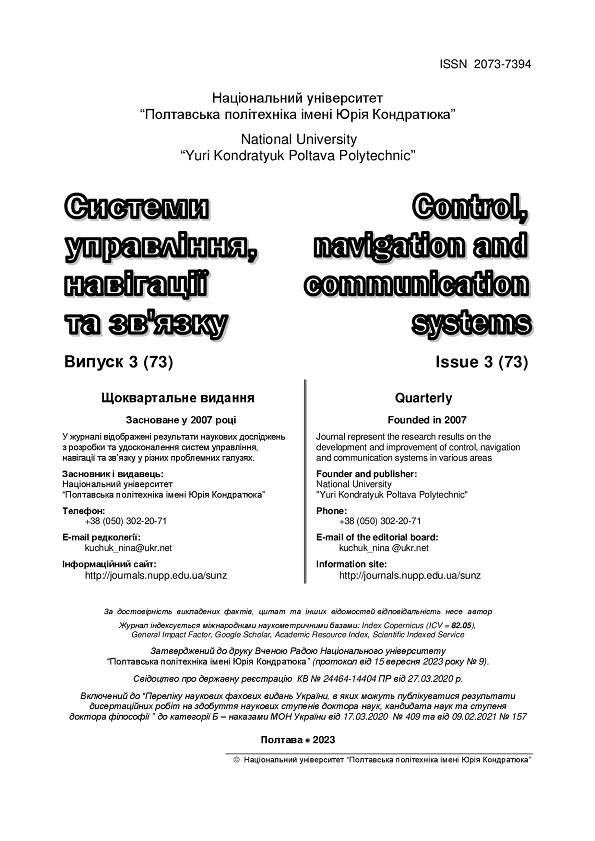ASSESSMENT OF DEAD ZONE OF JOINTLY OPERATING RADARS
DOI:
https://doi.org/10.26906/SUNZ.2023.3.171Keywords:
unmanned aerial vehicles, dead zone, radiolocation area, effective reflection area, radiolocation stationAbstract
Research relevance. With the emergence of unmanned aerial vehicles, the assignments of combating them have also become significantly more relevant. Today, operational countermeasures against UAVs are of great importance. Modern UAVs are capable not only of conducting video reconnaissance in a certain area, but also of observing a specific object for a long time and striking it. After detecting and identifying UAVs by RLS, it is necessary to take measures to neutralize them. In the paper, a mathematical model of the evaluation of the dead zone of RLS working together for the effective detection of unmanned aerial vehicles was established and a comparison of the dead zones was made on concrete examples. The purpose of the research work is to solve the problem of effective placement of jointly operating RLS by mathematical methods for nonobserved remaining part of them had minimal volume and to select the necessary placement scheme. The following tasks are solved in the article: analysis of the characteristics of the radar field; development of a mathematical model for evaluating the dead zone of joint radar stations; evaluation of some accommodation options. The following research methods are used to solve the issues: theoretical analysis, mathematical modeling, comparative analysis. The following results were obtained: it was observed that the dead zone was reduced by 1.6 times in the four-station square arrangement scheme, and by 1.3 times in the three-station triangular arrangement scheme. Conclusions: From the comparison of the obtained numbers, it can be concluded that the creation of a radiolocation area by placing RLSs on the vertices of equilateral triangles (in the form of a checkerboard) is more economically profitable, as it requires fewer stations.Downloads
References
Hashimov, E.G., Maharramov R.R. Methods of effective detection of unmanned aerial vehicles // Проблеми інформатизації. Тези доповiдей 9- i мiжн. наук.-техн. конф. Т. 1. -Черкаси – Харків-Баку – Бельсько-Бяла: 18 – 19.11.2021, -с.118-119. URL: https://repository.kpi.kharkov.ua/server/api/core/bitstreams/b024598b-3c0d-4c71-b090-f631ee7d7e75/content
Hashimov, E.G., Maharramov R.R. Methods of effective influencing UAVs // Сучаснi напрями розвитку iнформацийнокомунiкацiйних технологiй та засобiв управлiння. Мат. 10-i мiжн. НТК, 9-10.04.2020. Т. 1. Баку-Харкiв-Жилiна, 2020, с.27. URL: https://repository.kpi.kharkov.ua/server/api/core/bitstreams/5c2b472b-5836-4c06-be9a-1c30ff0fde9c/content
Hashimov, E.G., Huseynov, B.S. Some aspects of the combat capabilities and application of modern UAVs // - Baku: National security and military sciences, - 2021. №3(7), -p.14-24. https://mod.gov.az//images/pdf/7440712d93276d13d09990c7a1e203ea.pdf
Bayramov A. A., Hashimov E. G. The numerical estimation method of a task success of UAV reconnaissance flight in mountainous battle condition //Сучасні інформаційні системи. – 2017. – №. 1,№ 2. – С. 70-73. https://repository.kpi.kharkov.ua/server/api/core/bitstreams/14f9ffe6-ab93-4995-b3f1-aefa743dd725/content
Vladimirov, V.M. Experimental investigations of the vertical sounding radar layout / V.M. Vladimirov, D.D.Dmitriev, V.N.Ratushniak, A.Y.Kolupaev // Journal of Siberian Federal University. Engineering & Technologies. -2022, 15(7). -p. 874–884. DOI:10.17516/1999-494X-0442
Hashimov, E.G., Maharramov, R.R., Muradov, S.A., Katekhliyev, V. Methods of detection of UAVs operating in a dead zone through RLS // Patriotic war: 44-day victory chronicle. Materials of the republican scientific-practical conference dedicated to the 2nd anniversary of the victory in the 44-day Patriotic War. - Baku: November 2-3, 2022, p. 176-178.
Filin, E.D., Kirichek, R.V. Approaches to the detection micro air vehicle based on the analysis of the electromagnetic spectrum // Информационные технологии и телекоммуникации. 2018. Т. 6. № 2. -p.87-93. URL: https://www.sut.ru/doci/nauka/journal/2018_2/87-93.pdf.
Еремин Г. В., Гаврилов А. Д., Назарчук И. И. Малоразмерные беспилотники – новая проблема для ПВО // Отвага [29.01.2015. № 6 (14). – URL:http://otvaga2004.ru/armiya-i-vpk/armiya-i-vpkvzglyad/malorazmernye-bespilotniki/.
Sydney, J. Freedberg, Jr. Dumb and cheap: When facing electronic warfare in Ukraine, small drones’ quantity is quality: [Electronic resource] / Breaking defense. – 13 june, 2023. URL: https://breakingdefense.com/2023/06/dumb-and-cheap-whenfacing-electronic-warfare-in-ukraine-small-drones-quantity-is-quality/
Старчак, М. Незаметная угроза: как беспилотники стали проблемой для ПВО: [Электронный ресурс] / Forbes. -17 may, 2023. https://www.forbes.ru/mneniya/489285-nezametnaa-ugroza-kak-bespilotniki-stali-problemoj-dla-pvo
Murzak V. V., Gribov, A.S. Metodology for assesing the radar visibility zone under interference conditions // -Ярославль: Вестник ЯВВУ ПВО, -2021, №4. – с.28-36
Khomenko I.V., Gizatullov O.D. The generalized indicator of the analysis of technical and economic characteristics of radio engineering means of the special purpose, J. Sib. Fed. Univ. Eng. technol., 2016, 9(4), p.500-512. DOI: 10.17516/1999-494X2016-9-4-500-512.
Klimov F.N., Kochev M. Yu., Garkin E.V., Lunkov A.P. On some problems of control over compliance with the procedure for the use of airspace. VII BC / NW 2015 № 2 (27): 13. 2. https://collectiontravels.ru/ssha/o-nekotoryh-problemah-kontrolya-zasoblyudeniem-poryadka-ispolzovaniya/. 18.11.2022.
What is the dead zone of RLS detection and how to determine it? https://studfile.net/preview/8961005/page:11/
Brzozowski, M., Pakowski, M., Nowakowski, M., Myszka, M., Michalczewski, M. Radiolocation Devices for Detection and Tracking Small High-Speed Ballistic Objects - Features, Applications, and Methods of Tests // Sensors, - 2019, 19(24): 5362. https://doi.org/10.3390/s19245362
Tomusyak A.A., Trokhimenko V.S., Shunda N.M. Geometry. Part 1: Analytical geometry / Vinnitsa, 2002, - 244 p.
Dombrovsky V.A. and others. Vishcha Mathematics: Podruchnik / Dombrovskiy V.A., Krizhanivskiy I.M., Mats'kiv R.S., Migovich F.M., Nemish V.M., Okrepky B.S., Khoma G.P., Shelestovska M.Ya.; edited by Shinkarika M.I. – Ternopil: Vidavnitstvo Karp’yuk, 2003 – 480 p.




